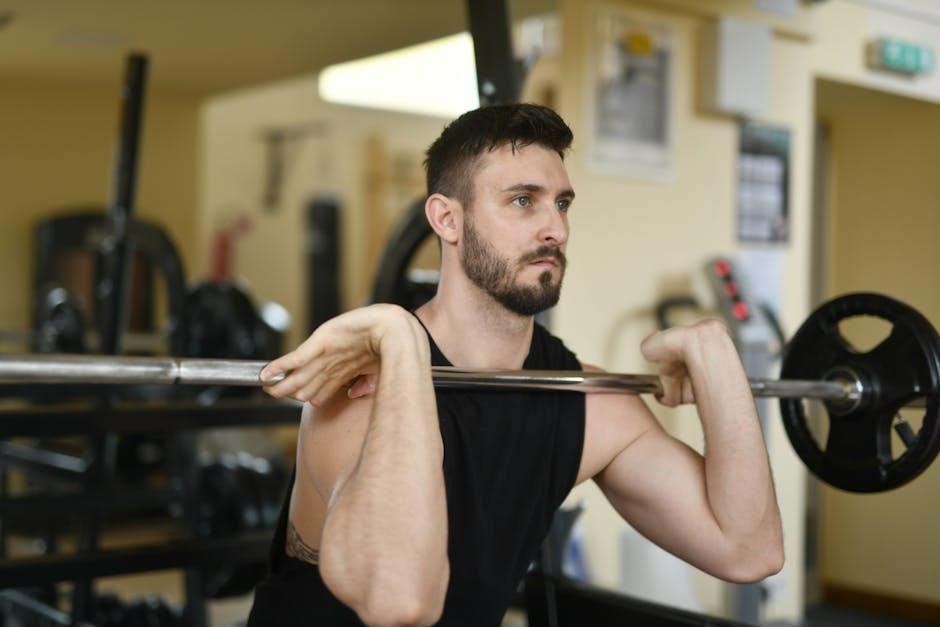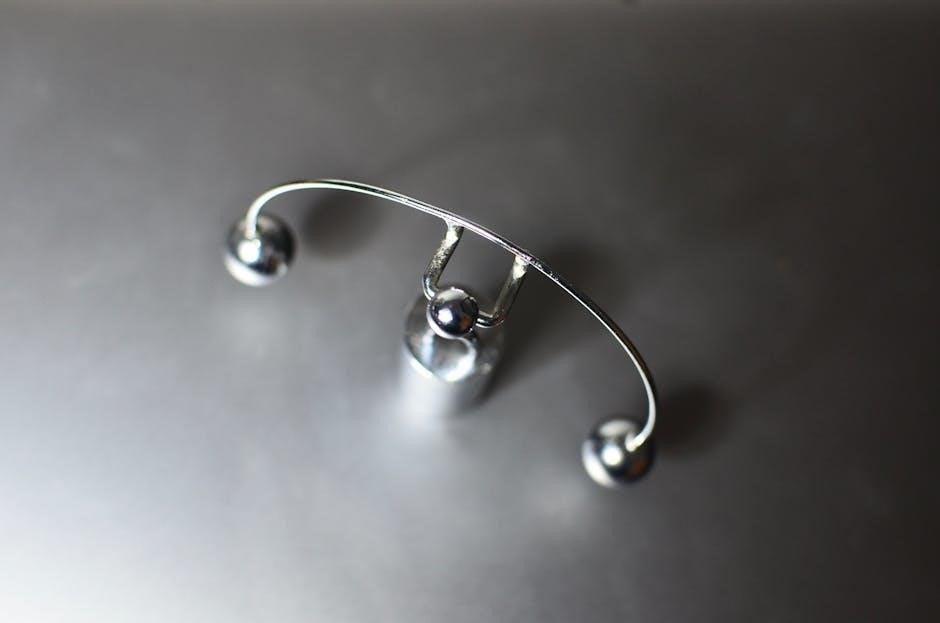Shoulder pendulum exercises are a series of gentle, low-intensity movements designed to improve mobility and reduce stiffness in the shoulder joint․ Often prescribed in physical therapy, these exercises are particularly beneficial for individuals recovering from shoulder injuries, surgeries, or conditions like frozen shoulder․ By promoting blood flow and gradually increasing range of motion, pendulum exercises help restore functionality without straining the shoulder․ They are simple to perform and can be done at home or in a clinical setting, making them an accessible and effective rehabilitation tool․
What Are Shoulder Pendulum Exercises?
Shoulder pendulum exercises are gentle, low-intensity movements designed to maintain or improve shoulder mobility․ They involve bending at the waist, allowing the arm to dangle, and performing controlled swings in various directions, such as front-to-back, side-to-side, or circular patterns․ These exercises are typically performed without weights and focus on relaxed, passive motion․ They are often recommended in the early stages of shoulder rehabilitation, post-surgery, or for conditions like frozen shoulder, to promote healing and maintain joint flexibility without overexertion․
The Importance of Shoulder Mobility
Shoulder mobility is crucial for maintaining proper joint function and overall upper body movement․ Limited mobility can lead to stiffness, pain, and reduced ability to perform daily activities․ Pendulum exercises play a vital role in preserving and enhancing this mobility, especially during recovery․ By promoting blood flow and reducing stiffness, they help restore natural movement patterns․ Improved shoulder mobility also prevents long-term complications like frozen shoulder and supports the healing process after injuries or surgeries, ensuring better quality of life and functional independence․
Who Can Benefit from Pendulum Exercises?
Pendulum exercises are highly beneficial for individuals recovering from shoulder injuries, surgeries, or chronic conditions like frozen shoulder․ They are ideal for those with limited mobility, as they are gentle and low-impact․ Post-surgical patients, particularly after shoulder surgeries, can use these exercises to maintain joint flexibility during recovery․ Additionally, individuals with shoulder pain or stiffness due to arthritis or dislocations can benefit, as pendulum movements help restore range of motion without strain․ They are also suitable for athletes seeking to improve shoulder mobility and prevent injuries, making them a versatile tool for various populations․

Understanding the Benefits of Shoulder Pendulum Exercises
Shoulder pendulum exercises enhance mobility, reduce stiffness, and alleviate pain, promoting gentle, controlled movement to restore function and strength, ideal for recovery and maintenance of shoulder health․
Improving Range of Motion
Shoulder pendulum exercises are highly effective for enhancing range of motion by promoting gentle, controlled movements of the shoulder joint․ These exercises target the muscles and ligaments surrounding the shoulder, helping to reduce stiffness and improve flexibility․ Regular practice can gradually restore natural movement, making everyday activities easier․ The swinging motions help break down adhesions and scar tissue, allowing for smoother articulation of the joint․ Over time, consistent practice can significantly increase mobility, reducing the risk of further injury and improving overall shoulder function․ They are particularly beneficial for individuals recovering from injuries or surgeries․
Reducing Shoulder Pain
Shoulder pendulum exercises are an excellent way to alleviate shoulder pain by gently mobilizing the joint and surrounding muscles․ The controlled, swinging motions help relax tense muscles, improve blood flow, and reduce stiffness․ These exercises are particularly effective for individuals with chronic pain, as they avoid putting excessive strain on the shoulder․ Regular practice can significantly lower pain levels, especially when performed with proper technique and consistency․ By addressing muscle imbalances and promoting relaxation, pendulum exercises provide a non-invasive and effective solution for managing shoulder pain․ They are often recommended as a first step in rehabilitation or pain management plans․
Promoting Healing After Injury or Surgery
Shoulder pendulum exercises are a gentle and effective way to promote healing after injury or surgery․ By maintaining joint mobility without excessive strain, these exercises prevent stiffness and encourage proper tissue repair․ They are often prescribed in physical therapy to support the recovery process, especially for individuals with limited arm movement․ Early implementation of pendulum exercises can help prevent complications like frozen shoulder and ensure a smoother transition to more advanced rehabilitation․ Patients are encouraged to follow a guided routine to avoid overexertion and support optimal recovery outcomes․

Medical Uses of Shoulder Pendulum Exercises
- Rehabilitation after shoulder injuries or surgeries․
- Managing frozen shoulder and joint stiffness․
- Aiding recovery post-shoulder dislocation or fractures․
Rehabilitation After Shoulder Surgery
Shoulder pendulum exercises are highly effective for rehabilitation after shoulder surgery․ They promote gentle movement, reducing stiffness and improving circulation without overexertion․ By bending at the waist and allowing the arm to swing freely, patients can gradually restore range of motion․ These exercises are often recommended in the early stages of recovery to prevent joint immobilization and strengthen surrounding muscles․ Guidance from a physical therapist is crucial to ensure proper technique and avoid complications․ Over time, incorporating variations like small weights can enhance strength and flexibility, aiding in a full recovery․ Consistency and patience are key for optimal results․
Managing Frozen Shoulder (Adhesive Capsulitis)
Shoulder pendulum exercises are a valuable tool for managing frozen shoulder, helping to reduce pain and stiffness․ By performing gentle, controlled swings, patients can gradually improve joint mobility without overstraining․ The exercises are particularly effective in the early stages of adhesive capsulitis, as they encourage blood flow and promote relaxation of tight shoulder muscles․ It’s essential to start with small, pain-free movements and gradually increase the range as comfort allows․ Regular practice, even for just a few minutes daily, can significantly aid in restoring flexibility and easing symptoms of frozen shoulder․
Post-Dislocation Recovery
Shoulder pendulum exercises are highly beneficial for post-dislocation recovery, helping to restore strength and flexibility without risking further injury․ These gentle movements promote healing by improving blood flow and reducing stiffness in the shoulder joint․ Patients can begin with small, controlled swings, gradually increasing the range as pain allows․ The exercises are particularly useful in the early stages of rehabilitation, as they minimize strain while encouraging natural movement․ Consistency is key to rebuilding stability and preventing future dislocations․ Always consult a healthcare provider to tailor the exercises to individual recovery needs․

A Step-by-Step Guide to Performing Shoulder Pendulum Exercises
Start with proper positioning, bend at the waist, and let the arm hang․ Gently swing the arm in small circles or straight lines, maintaining control and avoiding strain․ Gradually increase speed as comfort allows․ Focus on smooth, deliberate movements to promote healing and mobility without overexertion․ Always follow medical guidelines or therapist recommendations for optimal results․
Preparation and Positioning
To begin shoulder pendulum exercises, stand or sit in a comfortable position with your unaffected arm supported if needed․ Bend forward slightly at the hips, allowing your injured arm to hang freely․ Ensure your shoulder is relaxed and down, avoiding tension․ Place a pillow or towel under your forearm for support if recommended․ Start with slow, controlled movements, gradually increasing as comfort permits․ Proper positioning is key to avoid strain and maximize the effectiveness of the exercise․ Always consult a therapist or guide for precise alignment and technique․
Bending at the Waist for Proper Alignment
Bending at the waist is essential for proper alignment during shoulder pendulum exercises․ Stand with your feet shoulder-width apart and slowly bend forward at the hips, keeping your back straight․ Allow your injured arm to hang freely, ensuring your shoulder remains relaxed․ This position enables your arm to swing naturally without restriction․ Avoid bending from the neck or rounding your back, as this can strain other muscles․ Place a towel or pillow under your forearm if needed for comfort․ Proper alignment ensures the exercise targets the correct muscles and promotes effective healing․
Swinging the Arm Gently
Swinging the arm gently is the core movement of shoulder pendulum exercises․ Once properly positioned, allow your arm to swing freely in small, controlled arcs․ Start with front-to-back or side-to-side movements, gradually increasing the range as comfort allows․ Use a smooth, rhythmic motion, avoiding jerky or forced swings․ Perform the swings for 5-10 minutes, 2-3 times daily․ Keep your shoulder relaxed, letting gravity assist the movement․ Over time, you can introduce light circular motions․ This gentle swinging promotes blood flow, reduces stiffness, and enhances shoulder mobility without putting strain on the joint․

Common Variations of Shoulder Pendulum Exercises
Shoulder pendulum exercises include front-back, side-to-side, and circular swings․ Each variation targets different shoulder muscles, enhancing mobility and flexibility․ Start gently and progress gradually․
Front-Back Swings
Front-back swings involve bending at the waist and letting the arm swing gently forward and backward like a pendulum․ This motion is typically passive, meaning the arm moves without active muscle engagement․ It helps improve range of motion and reduce stiffness․ Start with small movements, gradually increasing the range as comfort allows․ This variation is excellent for individuals with limited mobility or pain, as it promotes gentle stretching without overexertion․ Consistency is key to seeing progress in shoulder flexibility and strength․
Side-to-Side Swings
Side-to-side swings are a variation of shoulder pendulum exercises where the arm moves laterally, swinging from one side of the body to the other․ This motion helps improve flexibility and reduces stiffness in the shoulder joint․ To perform, bend at the waist and let the arm hang freely, gently swinging it from side to side․ This exercise is particularly effective for enhancing lateral mobility and relieving tension․ It is often recommended for individuals recovering from shoulder injuries or surgery, as it promotes gentle, controlled movement without putting excessive strain on the joint․
Circular Movements
Circular movements are a variation of shoulder pendulum exercises where the arm moves in small circles, first clockwise and then counterclockwise․ This exercise helps improve joint mobility, strengthen muscles, and restore natural movement patterns․ To perform, bend forward at the waist, let the arm hang freely, and create small circular motions․ Gradually increase the size of the circles as mobility improves․ This gentle exercise is ideal for early stages of recovery, promoting flexibility and reducing stiffness without overexertion․ It is particularly beneficial for enhancing synovial fluid circulation, which supports joint health․

Safety and Precautions
- Stop immediately if pain occurs or worsens during exercises․
- Avoid overexertion to prevent further injury or strain․
- Maintain proper posture and technique to ensure safety․
- Consult a healthcare professional before starting any new routine․
Avoiding Overexertion
Avoiding overexertion is crucial when performing shoulder pendulum exercises to prevent further injury or strain․ Start with slow, controlled movements and gradually increase intensity as comfort allows․ Listen to your body and stop if pain arises․ Avoid using excessive force or momentum, as this can strain the shoulder joint․ Focus on gentle, rhythmic swings within a pain-free range․ Using light weights, if any, and maintaining proper breathing can help prevent overexertion․ Always prioritize controlled movements over speed or distance to ensure safety and effectiveness․ Consult a healthcare professional to tailor your routine to your specific needs and abilities․
Using Proper Technique
Proper technique is essential for effective and safe shoulder pendulum exercises․ Stand or bend at the waist with the injured arm hanging freely․ Keep your back straight and core engaged to maintain stability․ Hold onto a sturdy table or surface for support if needed․ Allow your arm to swing gently in small arcs without using muscle force․ Focus on letting gravity assist the movement rather than actively swinging your arm․ Avoid tensing your shoulder muscles, as this can hinder progress and cause strain․ Practice smooth, controlled motions to maximize benefits while minimizing the risk of injury or discomfort․
When to Stop if Pain Occurs
If pain occurs during shoulder pendulum exercises, stop immediately to prevent further injury․ Pain is a sign that something may be wrong, so it’s crucial to listen to your body․ Do not continue the exercise if it causes discomfort, as this could exacerbate the condition․ Rest the affected shoulder and apply ice if needed․ Consulting a healthcare professional is crucial to assess the situation and determine the appropriate next steps․ Resuming exercises should only happen under professional guidance to ensure safety and proper effectiveness․

Progressing with Shoulder Pendulum Exercises
As strength improves, increase the duration of pendulum swings and gradually incorporate light weights․ Introduce varied movements to enhance shoulder mobility and strength․ Always consult a therapist for personalized progression plans tailored to your recovery needs․
Increasing Duration and Frequency
Gradually extend the time spent on shoulder pendulum exercises to enhance flexibility and strength․ Start with short sessions, such as 5-10 minutes, and slowly increase by a few minutes weekly․ Aim to perform the exercises 2-3 times daily, ensuring consistent practice for optimal progress․ As comfort improves, increase the number of repetitions or sets․ Always maintain smooth, controlled movements and avoid bouncing, which can strain the shoulder․ Consult a healthcare provider to tailor the progression plan to your specific needs and recovery stage․ Patience and consistency are key to achieving lasting benefits․
Adding Light Weights Gradually
As shoulder mobility improves, light weights can be introduced to strengthen muscles․ Start with small, manageable weights, such as 1-2 pounds, and gradually increase as comfort allows․ Use a resistance band or hold a light object like a water bottle or can․ Maintain smooth, controlled movements without bouncing․ Avoid heavy weights that could strain the shoulder․ The goal is to build strength without compromising healing․ Always consult a healthcare provider before adding weights to ensure safety and effectiveness․ This progression helps restore shoulder function and prepares for more advanced exercises․
Incorporating Other Shoulder Exercises
In addition to pendulum exercises, integrating other shoulder movements can enhance recovery and strength; Wall slides, arm circles, and cross-body stretches are excellent complements․ These exercises improve flexibility and range of motion while strengthening surrounding muscles․ They can be done alongside pendulum swings to create a well-rounded routine․ Gradually introducing these movements ensures a balanced recovery․ Always prioritize proper form and consult a healthcare provider before adding new exercises to your regimen․ This holistic approach promotes long-term shoulder health and functionality, making it easier to perform daily activities with confidence․

Tools and Resources
Downloadable PDF guides provide detailed instructions and diagrams․ Video tutorials offer visual demonstrations, while mobile apps track progress and remind you to exercise consistently․
Using a Shoulder Exercise PDF Guide
A shoulder exercise PDF guide is an excellent resource for structured routines․ It often includes step-by-step instructions, diagrams, and progress tracking sheets․ Having a printable guide ensures consistency, allowing you to follow exercises like pendulum swings and stretches anywhere․ Many PDFs are designed by physical therapists, offering professional guidance․ They also provide visual aids, making it easier to understand proper form․ Regular use of a PDF guide can enhance your commitment to recovery or fitness goals by keeping the routine organized and accessible at all times․ It’s a valuable tool for both home and clinical settings․
Video Demonstrations for Proper Form
Video demonstrations are invaluable for mastering proper form in shoulder pendulum exercises․ They provide visual guidance, helping users understand movement dynamics and alignment․ Many videos, often created by physical therapists, detail each step, ensuring safety and effectiveness․ Watching demonstrations can prevent improper techniques that might lead to injury․ Additionally, videos allow users to pause and rewind, making learning easier․ They are particularly useful for those new to the exercises or recovering from injuries․ Accessing high-quality videos ensures that individuals perform pendulum swings correctly, maximizing benefits and minimizing risks․
Physical Therapy Recommendations
Physical therapists often recommend shoulder pendulum exercises as part of a rehabilitation program․ They emphasize proper technique to avoid injury and maximize benefits․ Therapists may tailor exercises to individual needs, adjusting swing ranges or durations․ Gradual progression is encouraged to strengthen muscles without overexertion․ Supervision by a professional ensures safety, especially for post-surgery or injury patients․ Regular follow-ups help track progress and adjust routines as needed․ Communication with your therapist is key to achieving optimal results and preventing complications․ Their expertise guarantees a personalized approach, making pendulum exercises more effective and aligned with your recovery goals․

Sample Shoulder Pendulum Exercise Routine
Start with a 5-minute warm-up, then perform 10-15 gentle swings in multiple directions․ Repeat for 3 sets, focusing on controlled, pain-free movements․ Finish with a cool-down stretch․
Warm-Up and Stretching
Begin with a gentle 5-10 minute warm-up to prepare your shoulders for exercises․ Start with arm circles: hold your arms straight out to the sides and make small circles forward for 30 seconds, then backward for another 30 seconds․ Next, perform shoulder rolls: roll your shoulders forward and backward in a circular motion for 20-30 seconds․ Gently tilt your head from side to side and rotate your neck slowly to loosen up the area․ Finish with light dynamic stretches, such as cross-body arm stretches or side stretches, to improve flexibility and reduce stiffness before starting the pendulum swings․
Core Exercise: Pendulum Swings
Bend at the waist, letting your arm hang straight down from your shoulder․ Gently swing your arm in small circles, first clockwise for 5-10 repetitions, then counterclockwise for the same duration․ Gradually increase the size of the circles as comfort allows, but avoid forcing movement․ Perform 3 sets in each direction, resting briefly between sets․ Keep your shoulder relaxed and focus on smooth, controlled motions․ Breathe naturally, inhaling and exhaling rhythmically as you swing․ If pain occurs, stop immediately and consult a healthcare professional․ Over time, you can progress by adding light weights to enhance the exercise․
Cool-Down and Relaxation
After completing the pendulum swings, gently slow your movements and transition into a cool-down․ Perform static stretches for your shoulders, holding each stretch for 20-30 seconds to release tension․ Focus on gentle neck rolls, shoulder shrugs, and chest-opening stretches to enhance relaxation․ Practice deep breathing exercises to calm your mind and reduce muscle stiffness․ End your session with a moment of stillness, allowing your body to recover․ This step is crucial for improving flexibility and reducing post-exercise muscle tension, ensuring a smooth transition back to daily activities․

Frequently Asked Questions
Common questions include optimal exercise frequency, pain management, and progression tips․ For detailed guidance, consult a shoulder pendulum exercises PDF or a healthcare professional․
How Often Should I Perform Pendulum Exercises?
Perform pendulum exercises 2–3 times daily for optimal results․ Start with 5–10 minute sessions and gradually increase to 10–15 minutes as comfort allows․ Consistency is key for improving shoulder mobility and reducing stiffness․ For post-surgery or injury recovery, follow the frequency recommended by your healthcare provider․ Overexertion can hinder progress, so balance is essential․ Refer to a shoulder pendulum exercises PDF for structured routines and progression tips tailored to your specific needs or condition․
Can I Do These Exercises at Home?
Yes, shoulder pendulum exercises can easily be performed at home with minimal equipment․ They require a stable surface, such as a table or counter, for support․ Ensure proper form by bending at the waist and letting your arm swing gently․ A shoulder pendulum exercises PDF often includes visual guides and step-by-step instructions, making it easy to follow along at home․ Start slowly, focus on controlled movements, and avoid overexertion․ For best results, practice in a quiet, distraction-free space where you can maintain focus on your form and breathing․
What If I Experience Pain During the Exercises?
If you experience pain during shoulder pendulum exercises, stop immediately and rest․ Mild discomfort is normal, but sharp pain may indicate overexertion or improper form․ Consult a healthcare professional to rule out underlying issues․ Adjust your technique or reduce the range of motion if pain persists․ Apply ice to the shoulder to alleviate discomfort․ Always follow the guidelines in a shoulder pendulum exercises PDF to ensure proper form․ If pain continues, consider consulting a physical therapist for personalized adjustments and supervision․
Shoulder pendulum exercises are a valuable tool for improving mobility and reducing pain․ Consistent practice, guided by a shoulder pendulum exercises PDF, enhances recovery and strength․
Final Thoughts on Shoulder Pendulum Exercises
Shoulder pendulum exercises are a simple yet effective way to enhance mobility, reduce stiffness, and promote healing․ For those seeking structured guidance, a shoulder pendulum exercises PDF provides clear instructions and visual aids, ensuring proper form and progression․ These exercises are particularly beneficial for post-surgery recovery, managing frozen shoulder, or improving range of motion․ Consistency is key to achieving lasting benefits, making a downloadable guide an invaluable resource for home or clinical use․ By following a well-designed plan, individuals can safely restore shoulder function and strength over time․
Encouragement to Consistently Practice
Consistency is crucial for maximizing the benefits of shoulder pendulum exercises․ Regular practice helps restore mobility, reduce stiffness, and strengthen the shoulder joint․ Even short daily sessions can lead to significant progress over time․ A shoulder pendulum exercises PDF can serve as a convenient guide, reminding you to stay on track and providing clear instructions․ Celebrate small milestones, like increased range of motion or reduced pain, to stay motivated․ Remember, consistent effort leads to lasting results and improved overall shoulder health․
Importance of Professional Guidance
Seeking professional guidance is essential for safely and effectively performing shoulder pendulum exercises․ A physical therapist or healthcare provider can tailor a routine to your specific needs, ensuring proper technique and avoiding further injury․ They can also monitor progress and adjust exercises as recovery advances․ Additionally, a shoulder pendulum exercises PDF can be a valuable resource, but it should complement, not replace, professional advice․ Consulting with a specialist ensures personalized care and helps address any underlying issues, promoting optimal healing and mobility․

Leave a Reply
You must be logged in to post a comment.